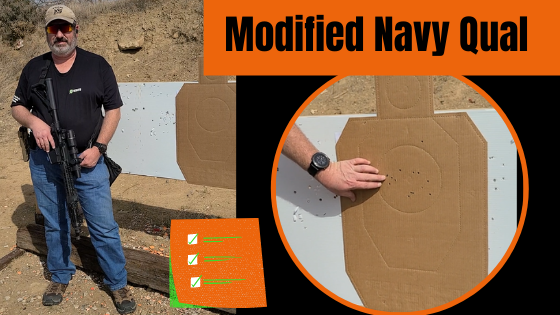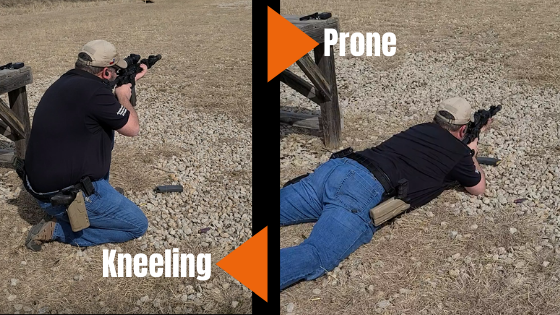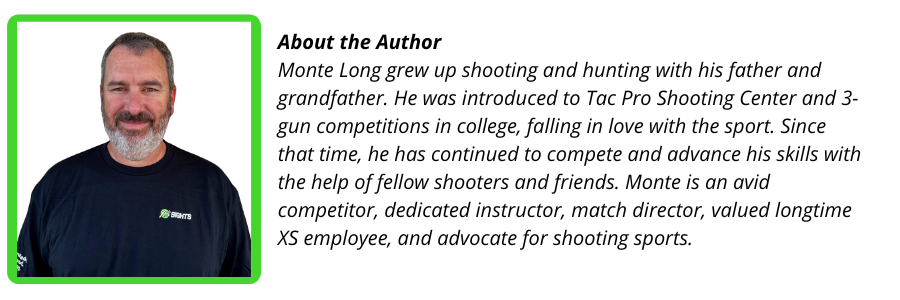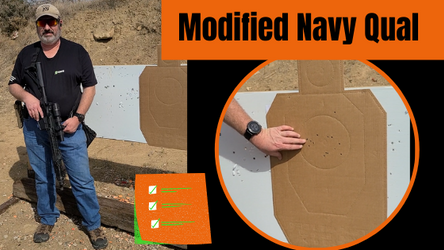Set Your Sights on this Challenge - Modified Navy Qual
Posted by Monte Long on Mar 17th 2022

A few weeks ago, we had a nice little snow and ice storm in the DFW metroplex. I know that for many folks that live North of Oklahoma, that's relatively common during the winter. That's not the case here in Texas; it tends to shut everything down.
During that period, I had to go to my parents' house to keep an eye on all the horses, dogs, and cats that my parents have. Since I would be there for a day or two, I figured why not take the night vision gear and see if I could find a few feral hogs.
After seeing what I thought was a hog rooting around under the fence line on one of Dad's wheat fields at about 175 yards, I spent 10 minutes moving into a position that allowed me to get a positive ID and a safe backstop.
After dispatching the hog, I started thinking. That was slightly atypical. Not the thinking part – the part about having 10 minutes to maneuver around on a pig.
Typically, time is at a premium, whether in a competitive environment, hunting, or in a defensive situation. Good gun handling and quick, accurate shots are necessary to be successful. Seldom do we have a lot of time to negotiate the situation we find ourselves in.
So, with that recent experience, I thought now would be a good time to talk about a carbine drill.
I learned this drill, the Modified Navy Qual, from a law enforcement instructor friend who learned it from Jeff Gonzales.
A former Navy SEAL, Jeff is the president of Trident Concepts, an Austin, Texas-based firearms training company. While I have not had the opportunity to take one of his classes, I've got several good friends who speak highly of Jeff and his instructional programs.
As I understand it, the Modified Navy Qual is a modification of a more extensive qualification course that the SEALs used prior to 9/11. Jeff and his team continued working with it and modifying it until they arrived at the current format.
Start off with a target with an 8" scoring circle. The Trident Concepts target is a great choice. However, I typically use an IDPA target as I usually have some in my gear. I've been known to stop at the grocery store en route to the range and pick up a package of paper plates if I forget to follow my own advice regarding range preparations.
Once you've got your target setup, move to 50 yards, and get three rifle magazines loaded with five rounds each. Grab your timer and get ready. On the buzzer, fire five rounds from standing. Reload the rifle, take a knee, and fire five rounds from the kneeling position. Once the gun runs dry, perform another reload, get into a prone position, and fire five more rounds. The "par" time is 25 seconds, though I rarely set the par time on my timer.
Scoring takes a bit of math.
Everyone starts with a score of 0, and the goal is to have the lowest score you can get. For every second under par time, you get to subtract one point. For every second over par time, you add 2 points. Misses earn you five points.
To qualify, you need to shoot a 40 or better. To break it down further and keep a bit better track of your progress, Jeff uses the following scoring:
Expert – 9 points or less
Sharpshooter – 10-25 points
Marksman – 26-40 points
Being accurate is much better than being fast. Let's say I shoot the drill in 24 seconds flat. That's a good start- I've got a -1 score. But then we score the target itself. Too bad, so sad, I managed to throw four rounds out, so 20 points get added.
After subtracting my -1 for being fast, I score a 19.
Now you get to shoot.
But, after you saw how my run went, you decided to take a bit more time. You shoot the drill in 33 seconds. That gives you a score of 16. But, when we look at your target, you've got all 15 rounds in the middle of the scoring ring. Your score stays at 16.
A lot is going on in this drill. You have to make rapid position changes, perform two reloads, and fire multiple rounds in a compressed time frame. That's a lot of skills you're working on while burning through less than a box of ammunition.
Remember to get a good, aggressive stance for the standing position so that you can drive the gun back onto the target after each shot. Make sure that you've got a good sight picture before pressing the trigger and work the trigger without moving the gun off target.
When you reload, work on being smooth and efficient with your movements. Personally, I use the beer can grip when I reload a carbine.
I find it easier to get the mag into the carbine and give it a quick tug to make sure it's locked into the receiver. Additionally, once the magazine is locked in, my thumb is right by the bolt release on an AR15.
For kneeling, you can work supported (support side elbow on support side knee) or unsupported. I typically shoot the kneeling supported – I pick up a bit of stability with little to no impact on the time spent getting into position. Either way, get into position quickly and make five good, accurate shots.

You can also shoot supported (monopod using the magazine) or just using your elbows in the prone position.
You should work both positions at various times. Why?
If you're wearing a bunch of gear – a plate carrier with plates and mag pouches mounted to the carrier, for example – you may not be able to get low enough to monopod on the magazine.
Additionally, suppose the target is mounted a bit high. In that case, you might not be able to aim at the scoring ring with the carbine resting on the magazine.
Give this one a try and let us know how you did. It's a good drill that works a lot of skills with minimal ammunition. If you ever have the opportunity to take a class from Jeff Gonzales at Trident Concepts, I would definitely recommend doing it.

About XS Sights: XS Sights is known for making the fastest sights in any light. For more than 25 years, the XS team has created some of the most innovative sights on the market today for pistols, rifles, and shotguns. Whether used for personal defense or hunting, these sights are designed and built to be the absolute best for their specific purpose. American Made. Texas Proud. 2A Strong.

